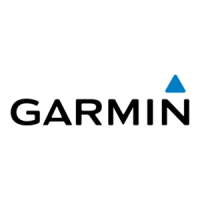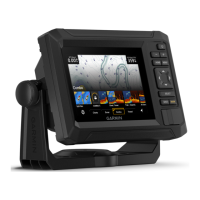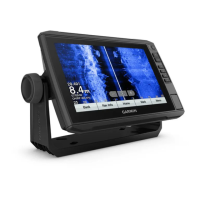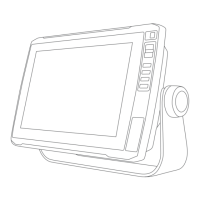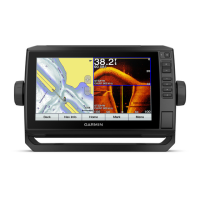Do you have a question about the Garmin ECHOMAP UHD2 and is the answer not in the manual?
| Sonar | Yes |
|---|---|
| GPS | Yes |
| Water Rating | IPX7 |
| NMEA 0183 Input Ports | 1 |
| NMEA 0183 Output Ports | 1 |
| Sonar Recording | Yes |
| Sonar History Rewind | Yes |
| Display Resolution | 800 x 480 pixels |
| Preloaded Maps | Yes |
| Connectivity | Wi-Fi |
| Mounting Options | Flush mount |
| Antenna | Internal |
| Transmitter Power | 500 W (RMS) |
| Sonar Frequencies | Traditional: 77/200 kHz |
| Maximum Depth | 2, 300 ft (Traditional) |
| Waypoints | 5, 000 |
| Routes | 100 |
Steps to connect the mobile device and app.
How to receive calls and texts on the chartplotter.
How to update device software via the app.
How to download and transfer chart updates via the app.
Steps for navigating to a specific location on the chart.
Details on optional premium chart features.
How to configure a collision alarm for safety zones.
How the system handles distress signals like EPIRBs.
Steps to navigate to a distress signal.
How to use color to represent water depths.
Steps to activate chart subscriptions for full features.
How to record and create contour maps.
Information about the community for sharing/downloading maps.
Navigates directly to a destination.
Creates a route with turns to a destination.
How to select destinations for navigation.
Steps to set up and follow a direct navigation course.
Basic information about waypoints.
How to find and navigate to saved waypoints.
Basic information about creating and managing routes.
How to create and follow a route from the current location.
How to create and store routes.
How to find and follow saved routes.
How to navigate parallel to a saved route.
How to plot the best path using chart data and vessel info.
Settings that influence Auto Guidance path calculation.
How to set the proximity of the Auto Guidance path to the shore.
Information about recording and managing boat tracks.
How to find and follow a previously recorded track.
Information about creating and managing boundaries.
How to set alarms for entering or exiting boundaries.
Features and settings related to sailing.
How to select vessel type for sailing functions.
Features for improving race start accuracy.
Visual aid for crossing the start line at optimal time/speed.
How to use the starting line guidance feature.
How to configure and display laylines for racing.
Features and settings for operating the sailboat autopilot.
How to set autopilot to maintain bearing relative to wind.
How to disable active or all sonar transmissions.
How sonar information is displayed in a circular depth scale.
Details on the ClearVü sonar view for structure imaging.
Details on the SideVü sonar view for side imaging.
Overview of different Panoptix sonar views available.
Description of the LiveVü Down sonar view.
Description of the LiveVü Forward sonar view.
Description of the RealVü 3D Forward sonar view.
Description of the RealVü 3D Down sonar view.
Description of the RealVü 3D Historical sonar view.
Description of the FrontVü sonar view for forward obstruction detection.
Description of the LiveScope sonar view for live imaging.
How to select the correct transducer for sonar functionality.
How to calibrate the internal compass.
How to share sonar data across the network.
Setup options for specific sonar types.
How to set up alarms for shallow water, deep water, fish detection, etc.
Settings for interference, surface noise, color gain, and bottom search limit.
Settings related to transducer installation like type, orientation, and beam width.
Information on adjusting sonar frequencies for different conditions.
Setup options for Panoptix sonar views.
Settings for LiveVü and FrontVü sonar views.
Settings for LiveScope and Perspective sonar views.
Installation settings specific to Panoptix transducers.
How to choose the source for heading data.
How to enable manual steering to disengage autopilot.
How to activate the autopilot system.
How to manually adjust heading while autopilot is engaged.
How to adjust heading using chartplotter controls.
Describes preset steering patterns for fishing and maneuvers.
How to connect a remote control to the autopilot.
How to connect the chartplotter to a Force trolling motor.
Various settings for the trolling motor like calibration and gains.
Calibrates trolling motor alignment with boat centerline.
How the chartplotter integrates with VHF radios for DSC.
How to navigate to a vessel sending a distress call.
How to track vessels sending position reports.
How to navigate to a vessel that is being tracked.
How to set up and make routine calls via VHF radio.
Steps to initiate a routine call to a contact or AIS target.
How to view engine and fuel data from NMEA 2000 sensors.
How to display engine status alarms.
How to set the sailing wind gauge for true or apparent wind.
How to specify ranges for close-hauled wind gauges.
How to set operating limits for engine and fuel gauges.
How to view engine data from Mercury engines.
How to display Mercury engine data using an overlay.
How to control a Power-Pole anchor system.
How to configure the Power-Pole anchor installation mode.
How to enable and set the active Mercury Helm.
How to adjust trolling speed with Mercury engines.
How to set and adjust cruise control for Mercury engines.
How to view detailed engine data from Mercury engines.
Features and settings for digital switching systems.
Compensates depth readings for transducer installation.
Settings for connecting to external devices via NMEA and wireless.
How to set an alarm for low onboard fuel.
Overview of the ActiveCaptain and Garmin Express apps.
